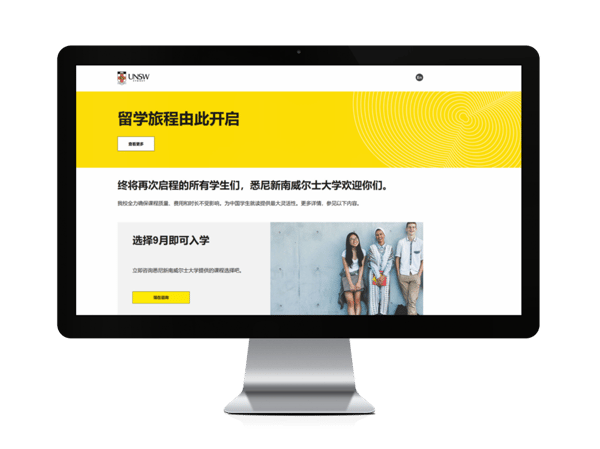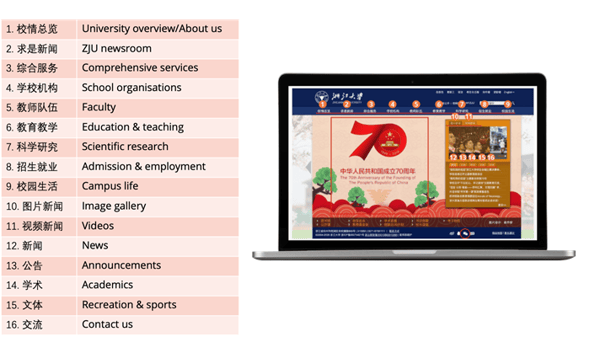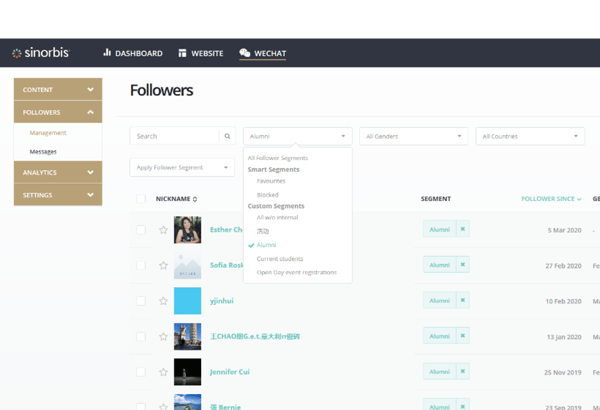Well over a year since COVID-19 heavily disrupted our lives, we are slowly seeing a return to something more like a pre-COVID world.
The reality is, however, we are moving into a post-COVID world. A year of disruption to the way education institutions operate around international student recruitment has seen huge changes, with potentially more to come.
Most obvious is being more agile around delivery modes both to retain as many current students as possible and continue to attract prospects. This has seen education institutions pivot primarily to online delivery models but has also led to some left-of-centre approaches to deliver. The ROSE Initiative by Rutgers University is an outstanding example of this.
In terms of educational marketing to Chinese students, the slow opening up of transnational movement will mean standard marketing and recruitment can occur once more.
However, as the saying goes, ‘never waste a good crisis!’
What this means in terms of China digital marketing is that the innovation we have seen during COVID is likely to continue to play an ongoing part in comprehensive marketing strategies. So, continuing to have a strong digital content strategy to communicate and engage with Chinese international students remains imperative.
To help education providers create a strong digital content strategy that will support their marketing and communication efforts in both the short and long term, in early 2020 I gave a webinar entitled ‘Developing a digital content strategy for Chinese international students’.
Here is a rundown of the information from that webinar.
Key factors influencing Chinese students’ choice of university/school
When developing a digital content strategy, it’s crucial to know what matters most to students and parents as they research potential international destinations and institutions. Data from our whitepaper The Learning Dragon shows that the factors that matter most to students are (in no particular order):
- University ranking
- Tuition fees
- Course content
- Student experience
- University culture and campus
- Safety concerns
- Living costs
As you can see from these factors, students are highly pragmatic in their decision-making when it comes to selecting an institution, considering both the quality of education as well as the comparative costs. This is no doubt linked to the increasing internationalisation and competitiveness of the education industry, giving Chinese international students an abundance of options.
While safety has always been a big priority for students, the COVID-19 crisis (which also brought about a rise in anti-foreign rhetoric), has heightened safety concerns. While this may recede somewhat as COVID does, institutions should still pay some heed to incorporating content that reassures students about security and safety measures that will be in place during their studies as well as access to healthcare.
Lifecycle of a Chinese international student
While the vast majority of an institution’s marketing efforts tend to be focused on recruitment, it’s important to consider the entire lifecycle of Chinese international students, and the relationship between the student and institution during each phase. Understanding and leveraging this in your digital content strategy can have a significant and long-term positive impact on the effectiveness of your marketing.
Before
A staggering 31% of Chinese students begin planning their overseas studies two years in advance. This means they are actively looking for information about potential destinations and institutions long before they start talking to an agent. This is why it is crucial that institutions have well-developed websites optimised for Chinese search engines and provide all the information a potential student might need. If you aren’t visible to students at this stage of the research process, you are very unlikely to even be considered when it comes time to apply.
Here are some topics that might be of interest to prospective students:
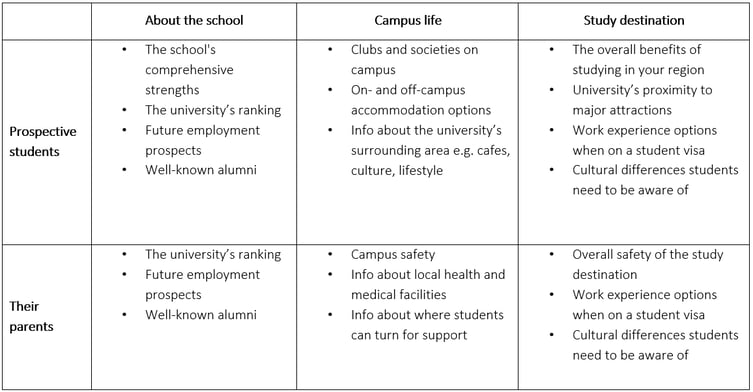
During
Currently enrolled international students are an often-overlooked audience for education institutions. This is a huge missed opportunity, as these students are likely the best advocates and recruitment agents you have at your disposal. Even one of our own staff members, Melody, decided to do her postgraduate degree at the University of New South Wales (UNSW) because of the WeChat posts she saw from friends who were studying there.
We are often asked about KOL (Key Opinion Leader or Influencer) marketing in education. What many universities fail to realise, is that they have an army of KOLs roaming around their campuses. Provide opportunities for students to produce content and incentivise students to share that content on their social media channels and voila - you have a KOL campaign!
Here are some topics that might be of interest to current students:

After
Just as with current international students, your institution’s alumni are often neglected in marketing efforts. And yet they present a key opportunity to expand your reputation. With an estimated 78% of Chinese international students return home after graduation, and many of these go on to have successful careers and move into positions of influence, making them excellent case studies that show potential students what may be possible for them. Losing touch with these alumni also means missing the opportunity for executive education and potentially losing donors.
Here are some topics that might be of interest to alumni:

Establishing effective foundations for your digital content strategy
Before you set out to create content for your various audiences, you must first ensure you have good foundations for your digital content strategy. Without this, any campaign will be ineffective.
Website
First, it’s important to understand the Chinese digital ecosystem is completely different to that in the West. Rather than Google, there’s Baidu, Sogou and Shenma; rather than Facebook, there’s WeChat; rather than Twitter, there’s Weibo etc. These analogies are far from perfect, as in many cases these platforms have evolved well beyond the capabilities of their Western counterparts.
Second, you cannot underestimate the importance of having a localised and optimised website. This does not mean simply translating your website to simplified Chinese. Many websites hosted outside the Great Firewall load so slowly in China that they are effectively invisible. We at Sinorbis analysed close to 2000 websites to see how they performed in China, and we found:
- 94% weren’t visible in China
- 94% had no or poor localisation for China
- 89% were not optimised for Chinese search engines.
There are several reasons why a website is such an essential part of your foundation for your digital content strategy, including:
- To establish a strong presence on Chinese search engines, which is often students’ first port of call when researching
- To help agents and institution partners promote your programs
- To engage with prospective students and parents directly and cultivate trust
- To provide students with validation that the information they have been provided by agents is correct, so they can make faster decisions
- To kick off other digital marketing activities e.g. paid media campaigns etc. (A website is necessary to create landing pages, which are essential tools for lead generation.)
- To integrate with and supplement your WeChat official account
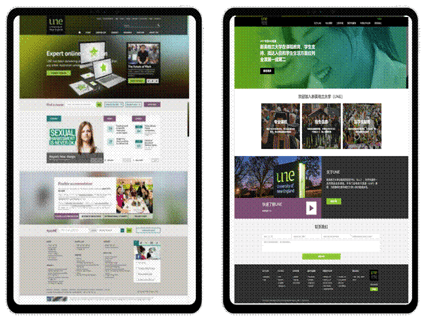
University of New England's English website (left) vs UNE's Chinese website
The other essential aspect of your digital content foundation is having a WeChat official account. WeChat is China’s biggest social media platform, and the stats around WeChat are impressive:
- 1.15 billion users
- Two-thirds of users log in over 10 times a day
- Users spend 30% of their time on mobile
- Users spent $1.7 billion in lifestyle spending
Because of its huge userbase, it’s a great way to stay in touch with your three main audiences: prospective students, current students and alumni. As a social media platform, WeChat also allows institutions to interact with its followers on a more personal level, giving brands the opportunity to flex their creativity and show more personality.
When it comes to WeChat, institutions must first decide which official account is best suited to their purposes:
Domestic:
While this type of account gives access to all the features, as well as domestic and overseas audiences, it is technically illegal for foreign businesses to set one up, as they are not able to get a Chinese business licence. The way most organisations get around this is by using a third party, a local business with a local licence, to run the account. The downside, however, is your asset is technically owned by this third party, giving you little recourse if your relationship with the third party sours.
International:
Foreign businesses are able to apply for an international account with their local business licence, but this type of account is far more constrained, with limited features and access only to overseas audiences. This is therefore unlikely to be suitable for your institution’s purposes.
Universal:
This is a new type of official account, which offers the best of both worlds. You can apply for the account using your local business licence, and get access to most of the features as well as domestic and overseas audiences. The downside is the application takes a fair bit longer, and is also much more expensive. However, we think the price is worth it to own your asset outright.
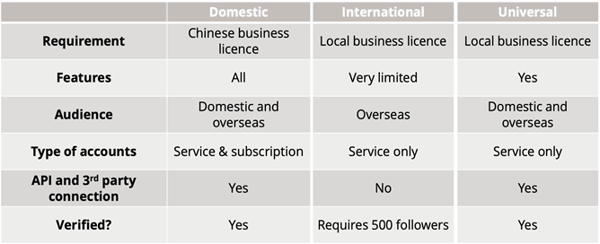
Framework for effective website and WeChat content
Together, your website and WeChat are strong content marketing tools. In the table below, you can see how your website and WeChat account play key roles at all stages of the student’s decision-making journey.

Here are a few tips on how to get the most value from both your website and WeChat account.
Website recommendations
There are many considerations when it comes to building a functional and effective website for Chinese users. Here, we’ll look at some of the most important aspects: navigation structure, design and menu hierarchy.
Navigation structure
Once you have a clear idea of the motivations of prospective international students and the sort of information that is important to them, this can inform the framework and content direction of your institution’s Chinese website.
Below is a good example of an effective navigation structure from Zhejiang University. As you can see, they’ve placed a lot of emphasis on the ‘hard facts’ about the institution, such as its faculties, scientific research, education and teaching and the admissions process. But there’s also room for ‘soft facts’, such as its recreation and sports offerings, information about campus life, an image gallery and videos. As a whole, this represents a good cross-section of the key considerations of prospective students and parents, current students and alumni.
Homepage design
While it might be tempting to try to squeeze as much information on your homepage as possible, it’s actually easier for users to find the information they’re looking for if the design is clean and concise. A visually appealing hero image has the added benefit of helping to communicate your brand personality.
Below is an example of a well-designed homepage from UNE’s Chinese website. The information is succinct, making it easy for users to navigate the page, and there are lots of images that draw the user’s eye.
You can also see how seamlessly the homepage design adapts to other devices like tablets and mobile phones. Given most Chinese users are on mobile devices, mobile responsiveness is very important in China.
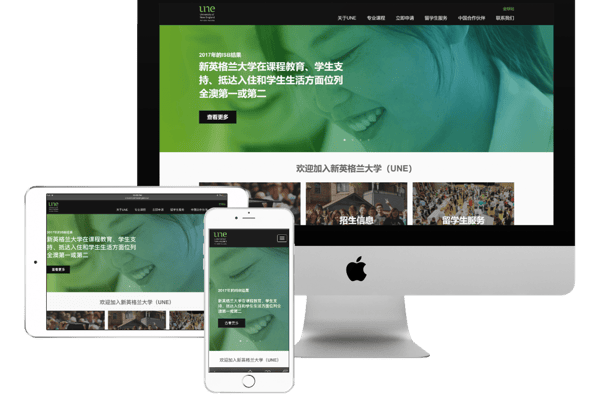
Website hierarchy
Following on from the previous suggestion, rather than trying to squeeze lots of information onto the homepage, it is better to add second- and third-level pages to enrich the content.
This example from the University of South Australia (Uni SA) website shows the menu hierarchy for their different schools, with the business school selected in blue. On the next image, we’re digging another level deeper to find information about the business school. A little bit further down the page, you can go even deeper into the site to a third level to learn about the university’s MBA program.
This multi-level structure doesn’t only help with your website’s SEO ranking, it also makes it much easier for visitors to navigate through the site.
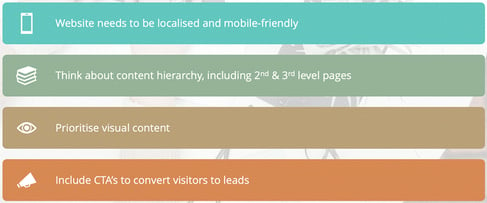
Summary of website recommendations
WeChat recommendations
WeChat’s platform is so stuffed with features that it may take some time before you’re fully across all of its capabilities. But just as with your website, it’s important to get the basics right. Here are our recommendations for getting the most value out of WeChat content.
Integrate your WeChat menu with your mobile-responsive website
What many don’t realise is that when you click on WeChat menu items, it doesn’t open a WeChat page but rather a page from your mobile-responsive website. The example below shows how a link in the Uni SA’s WeChat menu opens up a mobile-responsive webpage. The image on the right shows the same webpage on the desktop version of the site.
This of course opens up a world of possibilities, making WeChat a powerful weapon in your marketing arsenal in, allowing you to post both awareness and consideration content to users. From a content management perspective, it also has the benefit of eliminating the need for multiple updates.
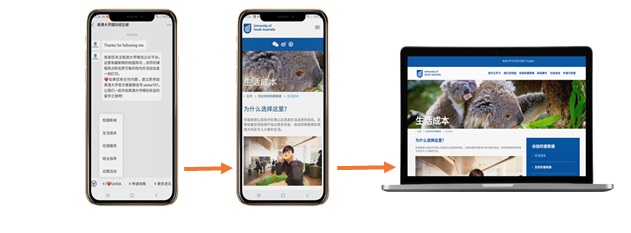
Set up your welcome message and auto response
Welcome messages are a seamless way to point new followers to your WeChat official account in the right direction. You can pre-configure different messages based on the number they enter once following.
As you can see from the example below, the welcome message for UNSW’s official WeChat account is friendly and concise, while its menu focuses on key information and covers many of the pressing queries users may have about the university.
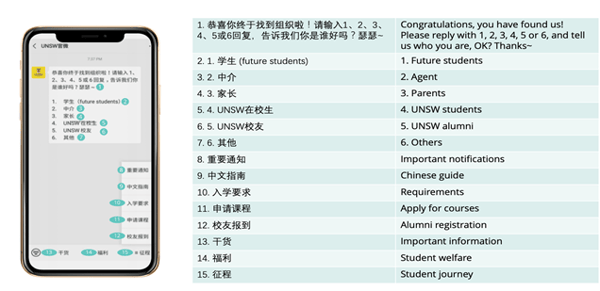
Here are some suggestions for setting up welcome messages and menus:
- The welcome message should correspond to the university’s brand positioning, and create a positive impression on the part of the new user.
- The message should be generic enough to address all audience segments.
- The menu should be constructed based on the needs of the relevant audience, and ordered in terms of importance to that audience.
Segment your audience for targeted content creation
The Sinorbis digital marketing platform allows you to segment your audience into different groups, meaning you can push relevant content to specific groups, whether that’s prospective students, current students or alumni. You could also use this feature to track the conversions of WeChat followers acquired from different media campaigns and events. In the example below, we have created different segments for alumni, current students and attendees of a recent open day event.
The primary purpose of establishing and promoting the university’s brand is to achieve its enrolment goals. Bearing this in mind, the proportion of posts directed towards prospective international students and their families should be relatively large (around 50%). Then, to help spread brand awareness further, the remaining proportion of the posts (around 50%) should be directed towards the other audience segments: current students and alumni.
- Posts directed towards potential international students may give a brief introduction of the university, outline new developments in certain faculties or disciplines, or provide students with the most up-to-date advice regarding enrollments.
- For current students, posts may introduce new or recently updated university services, or provide news about fellow students, such as who achieved certain awards, honours or distinctions, and so on.
- For alumni, posts may discuss some of the school's most-visited spots, detail recent back to-school activities, and so on. The best posts will address all audience segments at once.
The best posts will address all audience segments at once.
Get creative with your copy
WeChat is also an excellent channel for showing a more creative and playful side to your brand. Use attention-grabbing headlines to pique readers’ interest and capture a wider audience. The title should be tailored to the needs and wants of different audiences.
Don’t be afraid to use a casual tone and humour. The first example below, titled “Come to the Bowl of Ningbo University”, uses phrases from well-known and highly popular ads for M&Ms to discuss PhDs, making what may seem like a dry topic more appealing and enjoyable to read.
Consider what sort of information your audience wants or needs. The second example below is an article about the financial worth of the university’s alumni. This type of content is very appealing to prospective and current students who want to gain some idea of the type of wealth and value they might be able to one day generate after having studied at your institution.
Encourage interaction with users by sharing blessings and providing incentives for sharing content. The third example below is a post about the incentives being offered during the Mid-Autumn Festival.
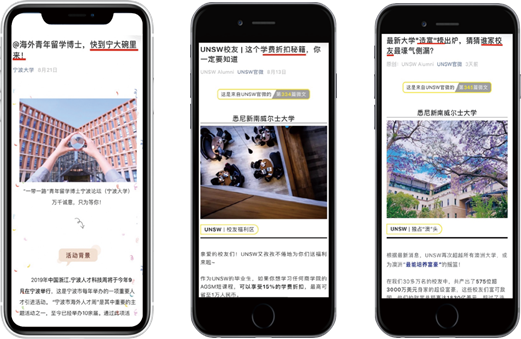
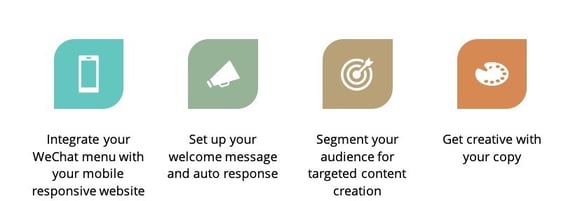
WeChat recommendations summary
Digital solutions for the COVID-19 crisis
The COVID-19 crisis hit the international education sector particularly hard, presenting many challenges.
As a result of China’s highly unique digital ecosystem, however, the crisis brought to light challenges particular to China:
- The difficulties of crisis communication: As many institutions discovered, it can be very difficult to communicate how a crisis may impact Chinese international students (travel bans, temporary campus or accommodation closures etc.) if you don’t have an established communication channel proven work within China’s more regulated digital ecosystem.
- Future recruitment difficulties: The usual offline tactics such as recruitment fairs, open day events, study tours and so on will slowly return as COVID recedes. However, with a return to more open borders still some time away, such will negatively impact international students recruitment from China in the short to medium term. This means that it will remain increasingly important to focus on digital solutions for China – not just to continue to weather the passing storm of COVID but also to prepare your institutions for the future.
Here, we’ll look at three good examples of COVID-19 crisis communication using digital solutions.
Example 1: Uni SA’s quick response
As mentioned above, the importance of maintaining one’s own digital channels in China really became apparent during the most disruptive times of the COVID-19 crisis.
Timely communication was particularly important for Chinese international students, not just because China was the country that was first affected, but also because the travel ban to Australia coincided with Chinese New Year and the beginning of the university year in Australia. This left thousands of students who were home for the holidays stranded in China with no idea what to do. Many students remain unable to return or (re)commence their studies in Australia, although more recently State governments have been formulating plans to once again allow some international student movement into the country.
Because Uni SA already had an established website and WeChat account prior to the COVID-19 crisis, it was able to communicate quickly to its students, providing them information about things like:
- What students should expect when they return (self-quarantine requirements etc.);
- What students could do if they were unable to return (online study options etc.);
- Who to contact including the phone number and email address.
It may sound incredibly simple, but this made all the differences to the students who were impacted.
And because both the website and WeChat were managed through the Sinorbis platform, Uni SA was able to make these updates in-house rather than having to rely on an agency in China to manage this for it, further reducing the time needed to reach its students.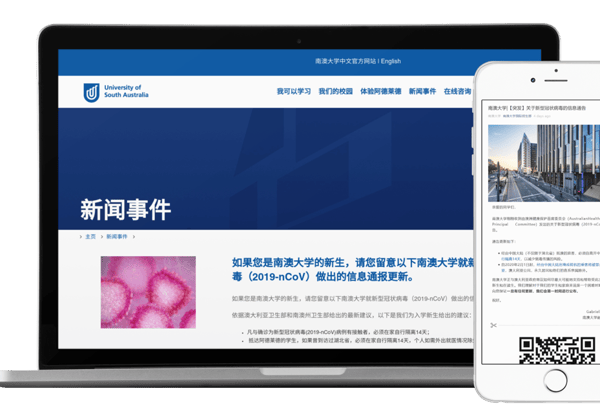
Example 2: Uni SA and the University of Wollongong reach out to students via WeChat
When it comes to providing regular updates to Chinese international students, there is probably no better channel than WeChat in China.
These two examples show how some universities in Australia have used their WeChat official accounts to keep current and prospective students up to date.
The first example shows Uni SA’s chief academic officer expressing her feelings towards the students affected by the COVID-19 situation with great authenticity and sincerity.
The second example from the University of Wollongong explains how students can stay updated by using its WeChat channel.
Another way to ensure students can quickly get the information they are looking for is by using keyword auto-responses. For example, you could provide students with information about online study options when they type in keywords like ‘online study’.
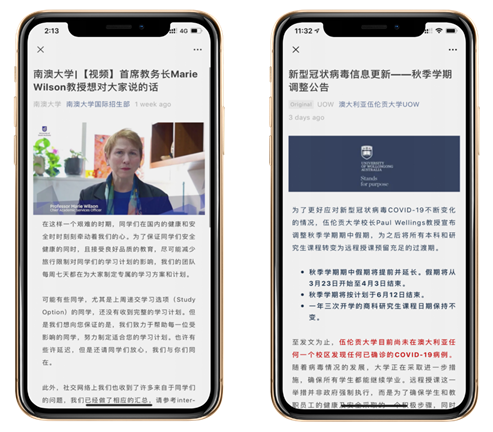
Example 3: UNSW communicates its advantage
The COVID-19 crisis also highlighted the importance of flexibility, and using all the tools and advantages at your disposal. The example below is a campaign from UNSW, highlighting its trimester system to prospective and current students. It was at the time attempting to illustrate that international students from China still had a chance to commence their studies at a later trimester without having to lose too much time.
Sinorbis helped UNSW get this campaign live in just three days!
